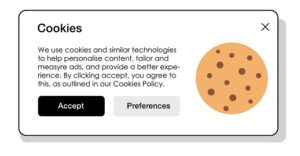
The Death of Third-Party Cookies and the Rise of Zero-Party Data

(elenabsl/Shutterstock)
During the Wild West phase of the big data experiment, third-party cookies lodged into people’s Web browsers were a major conduit of actionable data for companies far and wide. But with the rise in awareness of big data abuses–not to mention regulations like GDPR and CCPA–cookies have been on the outs, thereby forcing marketers to use other methods to obtain data about their customer and prospects. One of the most promising approaches is dubbed zero-party data.
Cookies have been a core staple of the feast of data that is the World Wide Web. They’ve been around since the very beginning, when Netscape pioneered the Web browser way back in 1992 and introduced the cookie as a way for websites to remember user information and preferences, such as the contents of a shopping cart or a user ID.
Over the years, the use of cookies proliferated, especially third-party cookies that track user behavior. In some cases, a user could have dozens of third-party cookies in their browser, surreptitiously gathering and reporting on the user’s travels across the Web.
This data was of great use to marketers, as it provided them with a detailed picture of the user’s online behavior. Advertisers also embraced the third-party cookie as a way to deliver targeted ads to specific users.
However, as concerns over privacy mounted and new regulations like GDPR and CCPA required organizations to get the consent of users before gathering personal information, questions started to be raised about third-party cookies. While some cookies remain necessary to make websites functional, such as to authenticate users as they browser an organization’s secure website, the writing has been on the wall for a while now: third-party tracking cookies are going away.

Don’t worry — we’re not asking you to enter your cookie preferences here (Kojaif Stock/Shutterstock)
When the GDPR went into effect several years ago, users started receiving pop-ups requesting permission to use cookies. By 2020, amid a widespread culture shift on data privacy, all of the major Web browsers had features to block third-party cookies. Google Chrome, which owns the largest share of the browser market, plans to start blocking third-party cookies by default in late 2024.
The death of third-party cookies has put marketers in a tough spot. Where are they going to get such detailed data about their potential users? Well, for starters, they’re not going to be able to gather it surreptitiously, as they did before, without violating the consent doctrine at the core of GPDR and CCPA. Any personal information they obtain will have to be accompanied by consent.
That is where zero-party data comes in.
Zero-Party Data
Zero-party data is information that a person intentionally and actively shares with a company or an organization. Instead of using surreptitious cookies to track the activity of people across the Internet–which violates the core tenet of consent at the heart of GDPR and CCPA–zero-party data is data that people share willingly and with full consent, which can make it easier to use in big data analysis.
Forrester is credited with naming this new data type. Fatemeh Khatibloo, a principal analyst with Forrester, likens zero-party data to “gold.”
“When a customer trusts a brand enough to provide this really meaningful data, it means that the brand doesn’t have to go off and infer what the customer wants or what [their] intentions are,” Khatibloo says in a 2018 Q&A.
Zero-party data can be gathered from a variety of sources, including: loyalty programs, interactive quizzes or game responses, user preference data, and purchase intentions.
It can be put to use in a variety of ways, including: creating a customer profile, improving customer service, making product recommendations, making better decisions, and improving ad targeting.
Zero-party data can actually be more valuable to businesses than third-party cookies because it is more accurate, specific, and reliable. The fact that zero-party data is collected with the user’s consent also means there are fewer privacy concerns.
In some ways, zero-party data is a close relative to first-party data, which is data that an organization has collected from its own operations and that it owns. It is a little further from second-party data, which is first-party data from a trusted partner.
However, zero-party data bears less similarity to third-party data, which is data that an organization buys or barters for. As third-party cookies go away, it’s possible that third-party data also becomes increasingly questionable in polite society.
While it takes a little more creativity to collect than data from third-party cookies, zero-party data has the potential to supercharge your big data efforts, without violating the trust that is so important to customers today.
Related Items:
A Culture Shift on Data Privacy
Security, Privacy, and Governance at the Data Crossroads in ‘22
From First to Third, and Alternative Too: A Guide to Data Types
































